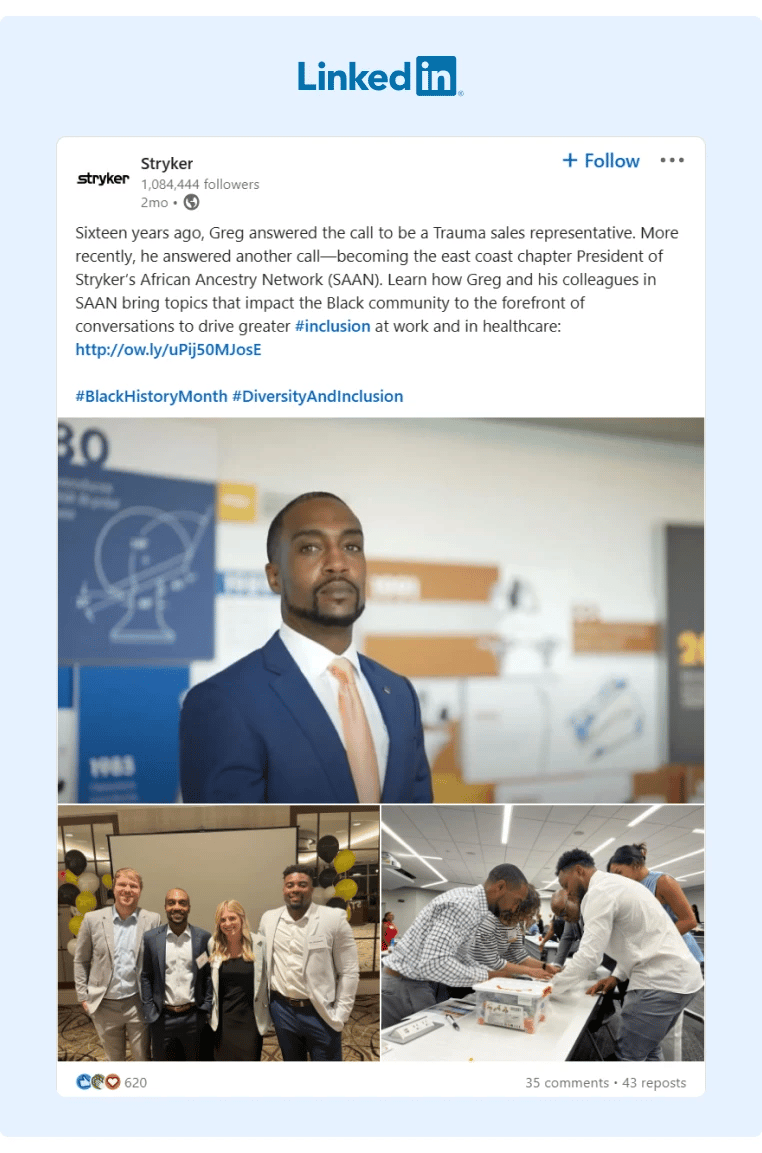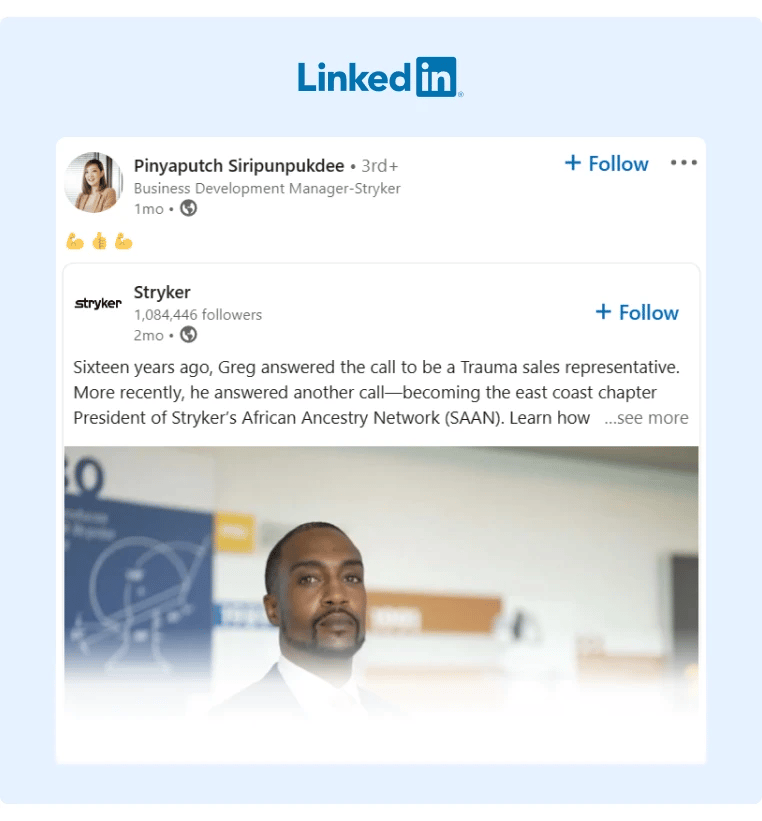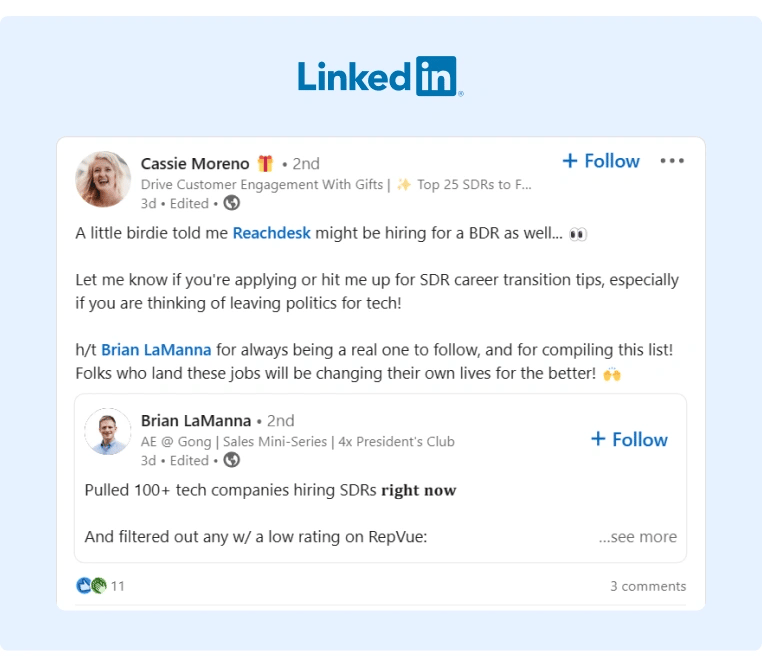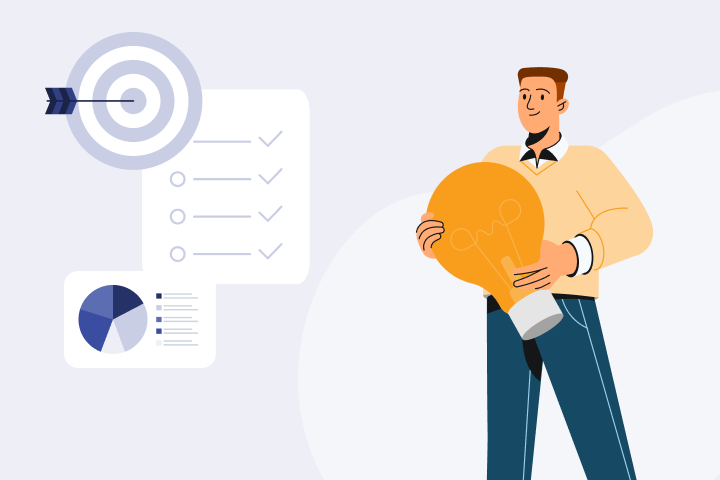Guide to Employee Advocacy on Social Media for 2025
Employees are usually your biggest brand advocates, as they’ve already chosen to dedicate most of their waking hours to your company’s mission and vision.
So, instead of hiring influencers or paying for social media ads, ask employees to share brand messages with their social networks. It’s an easy, effective, and low-cost method to promote important brand messages and elevate your employer branding.
This process is known as employee advocacy, and it’s one of the easiest ways to increase your brand’s reach.
Table of Contents |
What Is Employee Advocacy?
Employee advocacy is a marketing strategy where employees share brand messages and content with their professional networks (usually on social media).
Employee Advocacy Examples on Social Media
To illustrate how employee advocacy works, the post below is a great example.
You can see that the brand published a post promoting its diversity and inclusion practices.

Source: Stryker
Then, many other Stryker employees shared it with their networks:

Source: Pinyaputch Siripunpukdee
The original post on the branded company page received over 40 shares, 600 likes, and 35 comments, and that doesn't include the engagement accumulated by the employees' reshared versions of this post.
Here's a graphic that illustrates the power of this style of employee advocacy:
Sharing company content isn't the only form of employee advocacy.
You can also ask employees to create their own content promoting brand initiatives and post it to their social media accounts.
For example, SmartBug Media is a marketing agency that actively encourages its employees to promote company culture.
Here's an excellent example of an employee that created her own LinkedIn post that promotes the company culture:
Posts created by employees tend to perform better than branded content simply because people are more inclined to support their friends' content than branded content.
Benefits of Employee Advocacy on Social Media
Here are just a few of the top benefits of employee advocacy.
High-Quality Brand Awareness
People trust recommendations from their friends more than messages from unknown brands.
When employees share a brand message with their social networks, their friends are much more likely to note it than if you target those same people with a branded ad.
Cost-Effective Content Promotion
Ads are becoming increasingly expensive, so employee advocacy is a much more cost effective method to get your branded content in front of as many people as possible.
The only costs associated with employee advocacy are incentives you offer employee advocates (like an Amazon gift card) and the cost of an employee advocacy platform.
Generate New Leads
People like to do business with other people they like and respect.
If your sales reps consistently publish insightful content that resonates with their network, those connections are much more likely to reach out to your sales reps when they need your solution.
This strategy is called social selling, and instead of hounding prospects with cold messages, it attracts the right prospects to your brand by serving them relevant content.
Improve Customer Retention
In addition to generating leads, employee advocacy also helps retain customers by deepening customer relationships. It keeps your brand top of mind since they'll consistently see your helpful content in their social feeds.
In addition, if your employees consistently share content on how to use the product, your customers are more likely to use it more effectively and see a better ROI.
Attract Top Talent
The best talent surrounds themselves with other top performers, so helping your employees establish themselves as thought leaders can aid recruiting efforts. In addition, once your employees build their personal brands, you'll have a larger total network to source talent.

Key Challenges of Employee Advocacy on Social Media
If employee advocacy has so many benefits, why doesn't every brand have an employee advocacy strategy?
Keeping employees engaged is challenging.
Usually, marketing managers start their employee advocacy programs by sending out group emails or Slack messages asking the team to engage with content on social media.
Employees tend to respond to the first few requests, but engagement often drops off over time.
To solve this problem, we analyzed why employees quit engaging.
Here's what we discovered.
1. The Engagement Process Is Too Time-Consuming, and They Don't Realize the Value of Employee Advocacy
Your team members already have a long list of high value tasks to complete, so even though it only takes a few minutes to comment on a post, that time is precious to them and could be allocated to their to-do list.
In addition, many employees don't realize the value of employee advocacy, so it doesn't make sense for them to stop what they're working on (which they know is a high value task) and jump on social media to engage with content (which they don't realize is also a high value task).
2. Employees Don’t Know How They Should Engage on Social Media.
Many employees want to participate in your employee advocacy program, but they don't know which post they should engage with, what they should say, or how often they should engage.
For example, many employees worry that they'll say something off-brand and get in trouble – so it's safer for them to say nothing.
Your employee advocacy program will also be more effective if employees work together to boost the most important content rather than randomly choosing content to share.
3. Employees Never Receive Recognition for Their Efforts
Employees who consistently take time out of their day and put their to-do list on hold to engage with content often become discouraged if they never receive recognition for their efforts.
After a while, most of them give up altogether.
We felt these pain points first-hand and decided to solve them by building our own employee advocacy platform, GaggleAMP. Below, we'll show you how to create an employee advocacy strategy that keeps employees engaged for the long term.
A Step-by-Step Employee Advocacy Strategy
Here’s the step-by-step employee advocacy strategy that’s less time consuming and more effective at improving employee engagement than sending generic Slack and email engagement requests.
It uses our own platform, GaggleAMP, which we designed specifically to reduce the friction involved with traditional brand advocacy strategies.
You can also read our complete guide on employee advocacy strategy for more details.
Step 1: Create an Engagement Activity
GaggleAMP offers pre-made engagement activities and the ability to use AI-Powered Paraphrasing for all of the major social media platforms. Here's a sample of one of many LinkedIn engagement activities:

After selecting an engagement activity, you can fill it out with specific instructions including a link to the social media post they should engage with, what to say, and even an expiration date so that employees always have current content.
Providing specific engagement instructions on the engagement activity improves employee engagement rates because they’re no longer guessing which post to engage with or worried they’ll say something against your company’s social media policy.
Step 2: Assign the Engagement Activity To Relevant Employees
Once you've completed the engagement activity, you can assign it to an individual employee or a group of employees (like the sales team, executive team, or marketing team).

This makes it easy to scale your employee advocacy efforts while still ensuring each employee receives personalized engagement requests with relevant content.
Step 3: Employees Complete Their Personalized Engagement Activities
Employees receive notifications (via Slack or email) when you assign an engagement activity.
They can click on the link in the notification and enter their personal Gaggle to see an organized list of the new engagement activities you assigned.
They can then complete the engagement activities and schedule them to publish at a future date.
This improves employee engagement rates because they only have to spend a few minutes once per week or biweekly completing employee advocacy requests inside their Gaggle rather than logging into social media multiple times throughout the week to engage with new content.
Step 4: Track Employee Advocacy Campaign Results
Data helps win buy-in from stakeholders and employees, but employee advocacy ROI is notoriously difficult to track.
GaggleAMP's analytics dashboard solves this problem by giving you access to KPIs like:
- Estimated Earned Media Value (EEMV).
- Total organic reach.
- Number of social interactions/clicks.
- Total unique activities created.
- Number of shares.
- Most active members.
You can even use reports like the Benchmarking Report to see how your program compares to others with a similar size.

You and your employees have the same end goal; grow the business. If employees see that their efforts contribute to the business's growth, they're much more likely to participate.
Step 5: Reward Employees for Their Engagement Efforts
The success of your employee advocacy program is directly correlated with employee engagement rates, and we've found that the best way to improve employee engagement is to introduce gamification.
GaggleAMP offers a public leaderboard that ranks employees by their engagement efforts. This ignites friendly competition, and it also makes it easy for you to reward the most engaged employees.
If you’d like to see how you can use GaggleAMP to amplify your social media marketing efforts, schedule a demo today!
How To Select an Employee Advocacy Tool
As you search for an employee advocacy tool, you'll find an overwhelming number of options, and many appear quite similar on the surface.
Unfortunately, you typically only realize their limitations after implementation. To help you choose the best tool for your needs, here's a simple checklist you can use when evaluating each employee advocacy platform.
1. Can You Create and Assign Specific Engagement Requests to Specific Employees?
Most employee advocacy tools allow you to send reminders asking employees to engage with content, but only a select few (like GaggleAMP) allow you to create specific engagement activities.
If you look at the most successful employee advocacy programs, employees strategically work together to amplify the most important company news.
If you just send generic engagement reminders (as most employee advocacy tools are designed to do) everyone will likely engage with different content, diluting the power of employee advocacy.
This is a key reason why GaggleAMP allows you to create specific engagement activities to promote specific social media posts.
2. Do Employees Have Personalized Engagement Portals With Activity Scheduling Options?
Many employees quit engaging because it's too time-consuming. We've found the best way to reduce the time investment required from employees is to give each person a personalized portal with a list of their engagement activities and your specific engagement instructions.
This is how GaggleAMP is structured – employees log into their personalized Gaggle and can see a list of specific engagement activities with your instructions. Then, they just complete the specified actions and can check "employee advocacy" off their to-do list.
In contrast, many platforms send employees to a feed of social media content, and the employee has to scroll through a long list of content, choose a post to engage with, and think about what they should say and how they should engage. While these decisions may seem small, any additional work required from your employees will reduce engagement rates.
3. Can Employees Schedule Engagement Actions in Advance?
If employees have to log into their social media accounts several times per week to engage with company content, they'll probably forget at least once during the week.
It's also annoying for them to log into social media and engage with company content, as it's easy to get distracted on any social platform.
To make it easier, ensure the employee advocacy tool you select allows employees to schedule their engagement actions in advance.
In GaggleAMP, your employees can complete their engagement activities for the week in one sitting and schedule them to go live throughout the week.
4. Does It Offer Analytics and Gamification (Like a Leaderboard)?
Getting buy-in from your employees and executives is much easier if you can attach an ROI to your employee advocacy efforts. Most employee advocacy platforms offer some analytics but be sure to look at the level of detail.
For example, does it offer a breakdown of social media reach by employees and social media channels? Can it calculate the estimated earned media value (EEMV)? Will it show you who the most active members are?
In addition to these ROI-focused metrics, it's also important to have some gamification. At GaggleAMP, we offer a public leaderboard to ignite friendly competition and make it more fun for employees to engage. This also makes it easier for you as a manager to reward employees for their efforts so that they feel appreciated.
Start Your Formal Employee Advocacy Program Today
If you're ready to turn your employees into brand ambassadors and take your social media strategy to the next level, try an employee advocacy tool today!
If you want a solution that fits the above criteria, you can schedule a demo of GaggleAMP now.
Our team is happy to show you not only how the platform works, but also guide you through the process of developing your own effective employee advocacy strategy for social media.













